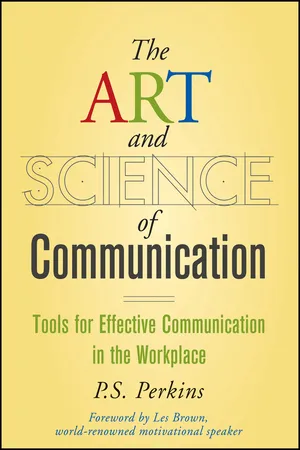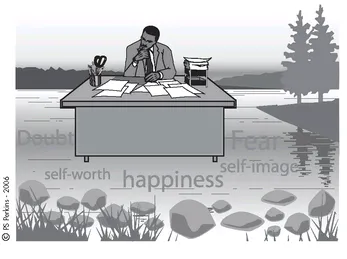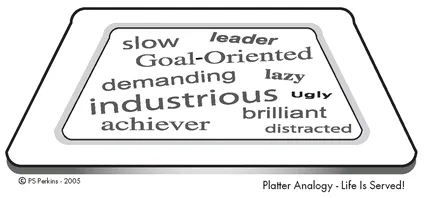
eBook - ePub
The Art and Science of Communication
Tools for Effective Communication in the Workplace
This is a test
- English
- ePUB (mobile friendly)
- Available on iOS & Android
eBook - ePub
The Art and Science of Communication
Tools for Effective Communication in the Workplace
Book details
Book preview
Table of contents
Citations
About This Book
The Art and Science of Communication shows you a new way to understand and use communication in the workplace. Revealing the seven types of communication we all use every day, the book shows you how to increase your communication effectiveness in any setting with practical techniques, analogies, and models that clearly explain the formulas for successful communication. Combining the science and art of communication into one effective formula, this book offers a straightforward and easy to understand plan for a more successful career.
Frequently asked questions
At the moment all of our mobile-responsive ePub books are available to download via the app. Most of our PDFs are also available to download and we're working on making the final remaining ones downloadable now. Learn more here.
Both plans give you full access to the library and all of Perlego’s features. The only differences are the price and subscription period: With the annual plan you’ll save around 30% compared to 12 months on the monthly plan.
We are an online textbook subscription service, where you can get access to an entire online library for less than the price of a single book per month. With over 1 million books across 1000+ topics, we’ve got you covered! Learn more here.
Look out for the read-aloud symbol on your next book to see if you can listen to it. The read-aloud tool reads text aloud for you, highlighting the text as it is being read. You can pause it, speed it up and slow it down. Learn more here.
Yes, you can access The Art and Science of Communication by P. S. Perkins in PDF and/or ePUB format, as well as other popular books in Business & Riunioni e presentazioni. We have over one million books available in our catalogue for you to explore.
CHAPTER 1 • STEP 1
Intrapersonal Communication
You Take You Wherever You Go
—P.S. Perkins
Give me a chance, Mr. Markham. I know I can lead the team. I ran this office for five years! Can’t you see through Jim? What’s wrong with you? It’s my turn. You can’t give it to him! It’s my promotion. Mine! Mine!”
Beep! Beep! Beep!
Now you’re awake and it was just a bad dream. Or was it? You’re about to start your day and you had a fretful night. You’re about to place your feet solidly back into the world. But wait. Before you do, are you sure you’re awake? Yes, I know your eyes are open and you feel your heart beating. You’re breathing, and you can probably feel the blood coursing through your veins if you’re quiet enough. But are you awake? What about that dream? What a way to start the very day you’re looking forward to your promotion. Let me give you a suggestion for getting back on the right track: Eat first, and then get out of bed. Yes, you read me right: eat first. We all understand breakfast is the most important meal of the day. We understand that we are what we eat. Many people are dedicated to starting their workday with the right kind of physical fuel to take them where they want to go. But what about their mental fuel? In the waking hours, just before you begin your workday, what kind of mental fuel do you feed yourself? It matters because this nourishment prepares you to handle the mental challenges of your day—personally, socially, and professionally.
“You are what you think” is the awareness and practice of the role thoughts fulfill in the moment-to-moment experiences of your life. Those moments begin over and over, begin with each waking breath as you move deliberately into consciousness. Your thoughts are the seeds that germinate the actions you will perform throughout your workday. What actions are you ready to perform today? It all depends on what thoughts you begin with every morning. Remember the expression “getting up on the wrong side of the bed”? We understand that this does not refer to a literal side of your physical bed! It is a metaphor for beginning your day with negative thoughts. And it’s really true. If you wake up with negative thoughts and don’t replace them immediately, you tend to carry those same negative thoughts and feelings around with you all day long. Ponder this—when have you had a bad start and been able to totally set it aside and perform your work duties without any mental or physical distractions? Chances are you took those same thoughts and emotions with you to the office and faked and/or fought your way through the day. You take you with you. You walked that attitude right into the office!
SELF-SABOTAGE OR SELF-FULFILLMENT?
The first step in achieving success in professional pursuits is mental preparation! We positively create our lives or we sabotage our lives. Most of us have associated sabotage with the act of undermining or backstabbing someone else. Truth sets you free—most individuals do more to undermine themselves than the combined efforts of everyone around them. The true sabotage lies within communication with oneself, in thoughts and words.

No one can think or speak to create your life for you!
Just as no one takes your place at work physically, no one can go to work for you mentally. That would be like asking a friend to eat your dinner and expecting you will be the one satisfied! The key is to arrive to work in a mental state you can positively thrive in. How can you use your thoughts to create the work environment you desire to prosper in?
DISCIPLINE OF THE MIND
The French philosopher Descartes was quoted as saying, “Except our own thoughts, there is nothing absolutely in our power.” It is this power of thought that introduces the first step of the Communication Staircase. Intrapersonal Communication is the communication you have with yourself about yourself and others. It shares the inner workings of your mind with yourself. How often would you say you engage in mental chatter during the day? You talk to yourself more than you talk to anyone else. The important point is how you talk to yourself—what you say to yourself verbally and nonverbally.
Sizing up your internal communication is the first step, the basis of all other communication experiences within your work environment. It requires a lot of critical thought and awareness. When an individual pays serious attention to the daily conversations he has with himself, and critically examines the quality of experiences springing forth from these self-talks, he will be able to control more positively the materialization of the experiences around him. I use this word “materialization” literally. With our words we materialize the actions and events of our daily lives. You are either your greatest ally or your greatest adversary. We are all given the same empty screen as we start the movie of life. Then that screen fills with images and messages from our internal selves materializing into our external surroundings, including work. This ability to create our own movie, our own lives, is the gift and power shared by all humans.

The universe is an equal opportunity employer giving each human the same vocation—to create their lives!
Our thoughts and words are the tools of creation, our pens and brushes. The process of creation is based on the same pattern of materialization shared by all species of creation. Specific conditions encourage creation. Seed + nutrient = tree. It is the same as Thought + word = action (or results). We create our lives with the brushstrokes of our thoughts and words! The Human Communication Cocreation Theory proposes that Conscious thoughts + words + feelings → subconscious = materialization of life. The purpose of the subconscious is to accept something as true, then create it. That’s why feelings play an important role. They generally do not lie. This knowledge is important to experiencing the type of work environment you are thriving in. The environment starts within you. Many of us can immediately identify our work environments as either positive or negative. But do you realize those labels come from inside you? Too often we look at either of these realms as being simply the result of someone else’s actions or responsibility—our bosses, employees, coworkers, management. Not true. Your life starts and ends with you. Do others play a role in the environmental attitude? Of course they do, but only to the extent that you allow them. And yes, sometimes the organizational environment can be so toxic that the decision before you is whether to stay and tough it out or walk away and create a new situation. But before you throw in the towel, take a look at what you are adding to the communication environment of the organization.
DIVE INTO YOUR LIFE!
Think of your life as a lake, a body of confined water. That which holds the lake in place—its banks, sediment, rocks, plants—represents your physical being, the body. The water in the lake represents your mind, your thoughts, the essence of your intellect or spirit that has no boundaries. Somehow the water, the internal you, continues to add to itself without ever overflowing its boundaries.
If I or someone else decided to fish in your lake on any given day at any given moment, what would we catch? Casting a rod into the depths of your mind would pull up what type of thoughts? When you go fishing into your own thoughts, second by second, what do you dredge up? How do you see yourself? What value do you place on yourself in comparison to others? Do you appreciate your coworkers? Do you respect your boss? Are you experiencing professional fulfillment at work?
Inside your lake are all the experiences and memories of your life. It is where you hold your values, attitudes, and beliefs. It is what houses that first birthday you remember, or your first kiss. It is that day at the park, or that first job and first promotion. It is also where you store the first harsh words you heard, the job you lost, emotional and physical abuse you suffered, the torment of bullies at school, the realization of unfairness, the desire for acceptance, and the negative feelings of unrealized expectations. All the contents add up to the image you have of yourself. When you go fishing, which experiences are most likely to be reeled in? Probably those tied to your deepest desires or fears, the ones that have the greatest impact on how you see yourself. It is these experiences that create the image you call you. Your self-esteem (how you feel about yourself) and your self-worth (the value you place on yourself in comparison to others) come from the depth of these waters. Most of us can honestly say we do not have the cleanest, most pristine body of mental thoughts to fish from (see Figure 1.1).
Figure 1.1 How Clean Is Your Lake?

Your workplace personality is the mirror image of your self-image. It determines how you act in front of your coworkers and how you thrive and compete in the organizational culture.

Your thoughts shape your self-image.
WHERE DID THAT THOUGHT COME FROM?
When we communicate with others, we are bringing forth from our minds (our lakes) the reality created by us or for us, one that may be very different than the reality the coworker/listener is operating in. Think of the words in your vocabulary. Where did they come from? Who do they belong to? You? What if I told you that you do not own any words! None of the words you present with authority belong to you, nor were they devised by your incredible imaginations. When you were born, you were given a platter of words meant to define your specific circumstances of birth: male, female, black, white, cute, ugly, rich, poor, privileged, untouchable, and so on. As you moved through life, in and out of experiences, relationships, jobs, careers, you amassed more and more words and labels, claiming and accepting them as your own. Did you choose these words, these labels? No, you did not, but you did quickly agree and conform to them. We all did. We did not understand that, from the beginning of the process of enculturation, we had a choice. The Sapir-Whorf hypothesis (named for Benjamin L. Whorf and Edward Sapir) is a linguistic “mould theory” that seeks to explain the impact of language on the individual, and how this impact, though very personal, is a shared experience for all humankind. In essence it states that language equals social reality. The words you use, most of them added to the language before you were born, have been assigned to you to define and determine how you should see and experience life (see Figure 1.2).
For example, think about the many Inuit words for snow versus the absence of the same word/phenomenon in the world of the Maasai tribe of Kenya. Different realities create different degrees of relevance for different words. What type of reality do your words come from? What words have been assigned to you in the workplace: boss, supervisor, worker, CEO, janitor, secretary? What adjectives: smart, clever, persistent or lazy, dull?
Figure 1.2 Your Words Served Up!

CREATING OUR SELF-IMAGE AT WORK
I remember an interview on Larry King Live in 1999 with the successful magicians and illusionists Siegfried and Roy. They were both discussing their childhood and their later ascent to fame. Siegfried talked about how his big break came after he left home. Apparently, his childhood was filled with negative mirror messages—the messages we receive about ourselves from others—and very little positive attention from his father. He said it was not until he was a very successful illusionist that his father ever really talked with him or acknowledged any aspect of his worth. Siegfried shared how troubling this was for him as a young man. His story is not unlike the story of millions who ...
Table of contents
- Title Page
- Copyright Page
- Dedication
- Foreword
- Acknowledgments
- Introduction
- CHAPTER 1 • STEP 1 - Intrapersonal Communication
- CHAPTER 2 • STEP 2 - Nonverbal Communication
- CHAPTER 3 • STEP 3 - Interpersonal Communication
- CHAPTER 4 • STEP 4 - Small-Group/ Organizational Communication
- CHAPTER 5 • STEP 5 - Public Communication
- CHAPTER 6 • STEP 6 - Mass Communication
- CHAPTER 7 • STEP 7 - Intercultural Communication
- EPILOGUE
- Index